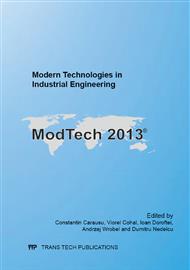p.594
p.603
p.607
p.612
p.618
p.624
p.628
p.634
p.639
Methods of Manufacturing Data Acquisition for Production Management - A Review
Abstract:
Knowledge about the state of the production system is necessary for proper management of a company. A modern company typically uses an ERP (Enterprise Resources Planning) system for management support, but still there is usually a gap between business and manufacturing layers of a company. There is a need to provide solutions allowing data acquisition directly from the production system, analyse this data and display it in a convenient form. Each type of production systems require a different approach to collect data because of variety of objects and conditions. The ability of production data acquisition mostly depends on the level of automation. This paper presents a comparison of methods of data acquisition from different types of manufacturing systems. Methods of data acquisition, from both automated and non-automated manufacturing systems, are described. Automation equipment resources (sensors, actuators, PLC, DCS, CNC, HMI, SCADA) and automatic identification systems (barcodes, RFID, vision systems etc.), as well as communication solutions (fieldbus, wired and wireless networks) and information exchange standards (OPC, MTConnect) are discussed.
Info:
Periodical:
Pages:
618-623
Citation:
Online since:
November 2013
Authors:
Price:
Сopyright:
© 2014 Trans Tech Publications Ltd. All Rights Reserved
Share:
Citation:


